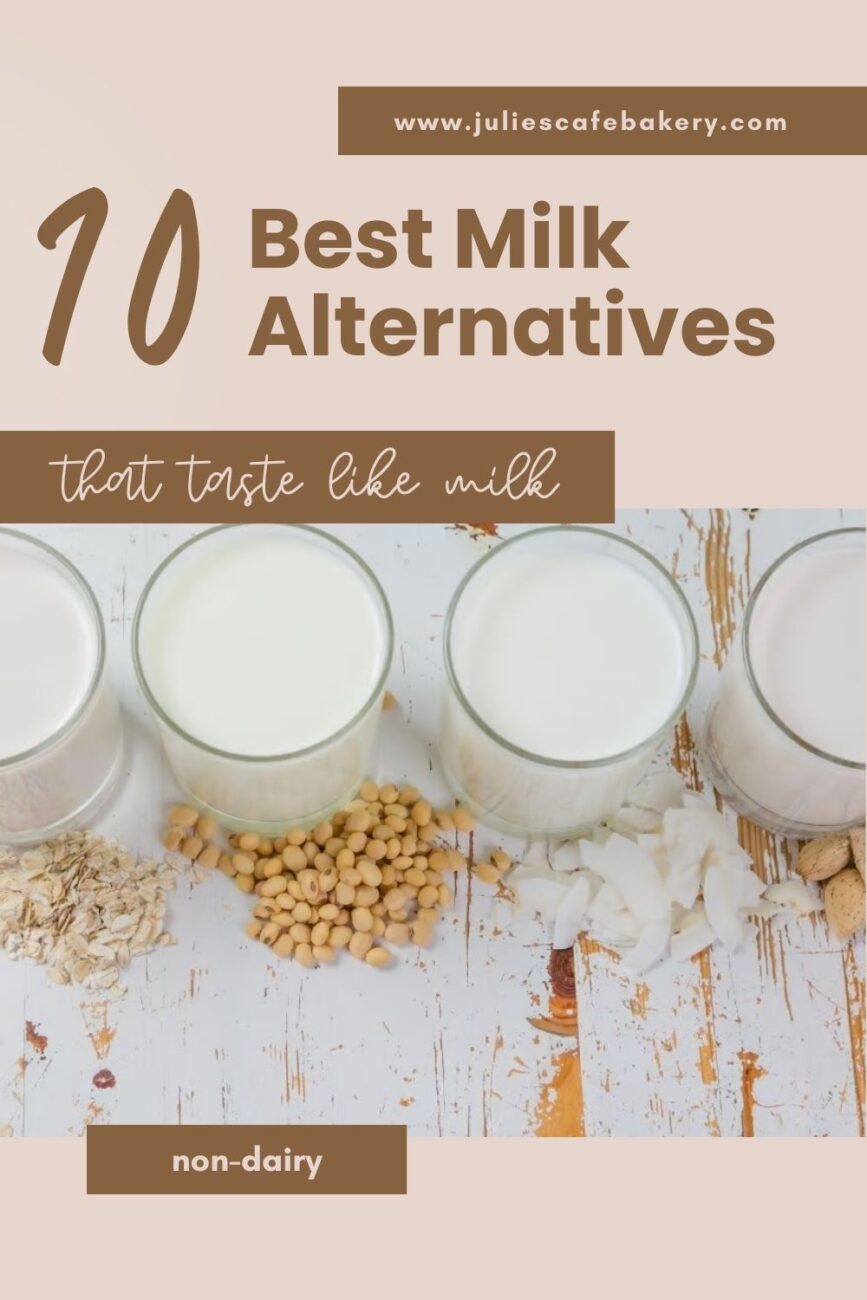10 Milk Alternatives That Taste Like Milk [Ranked]

Cow’s milk is a wonderful source of nutrients. But not everyone can enjoy its goodness, be it for allergies, lactose intolerance, or dietary restrictions. Fortunately for such people, a wide selection of non-dairy milk alternatives can deliver similar tastes and nutritional value.
So, in this article, we will look at some of the best alternatives to milk out there. We will judge them on their taste, creaminess, nutrients, and prowess in the kitchen. Hopefully, by the end, you will know exactly which milk alternative to choose that will best serve your dietary and culinary needs.
Which milk alternatives taste most like milk?
When choosing the right alternative to milk, taste is a pivotal factor. If it tastes nothing like milk, you cannot drink it or use it in your afternoon tea or pudding recipe.
Considering taste as the most important factor, here’s the list of the best milk alternatives. Luckily, I listed them from the ones that taste the closest to the milk to the ones that are not so close. So, let’s look at each of them in more detail.

Soy milk
Perhaps the most common non-dairy substitute for milk, soy milk is a popular choice in many cuisines. Though it originated in China, it has been used widely in Europe and North America for well over a century.
In terms of taste, this is one of the closest to cow’s milk. The big difference is in the fat content, which is significantly lower in soy milk. This makes soy milk taste thinner than regular, full-cream cow milk. But other than creaminess, the taste of soy can effectively invoke the feeling of drinking milk.
Soy milk contains almost the same amount of protein as milk, about 7 grams per cup (240 ml). [1] But it has significantly lower levels of calories and fat. Soy has nearly twice the amount of vitamin B12, while not being short on other important minerals and vitamins.
Another popular use of soy is to make tofu, a common substitute for meat in a vegan or vegetarian diet. Additionally, you can use it to make various items that would otherwise be dairy-based. For example, soy yogurt, soy custard, soy cheese, soy cream, etc. The best part is that you can use pretty much the same ratio as you would if you were using regular milk.

Oat milk
The most noticeable aspect of oat milk that makes it stand out as a milk alternative is just how creamy it is. In fact, it is the creamiest out of all the popular choices for milk substitutes available. A glass of oat milk tastes very similar to a glass of creamy cow’s milk.
A large part of this has to do with the fat content in oat milk. It is not surprising that the amount of fat in oat is one of the highest as well. It has 5 grams of fat in a 240 ml serving, which is 1 gram more than that of soy and nearly twice the amount in almond milk. This gives it a rich, creamy and thick texture. [2]
Derived from oat grains, this drink has become one of the most popular plant-based milks in the world. You can include it as a coffee creamer, or use it in your cake or custard recipe. You can even replace the milk in ice cream and pudding with oat milk. Or you can drink it on its own, much like you would drink regular milk.
Compared to cow’s milk, oat milk is a great source of vitamins D and B12, with little to no amount of cholesterol.
Pea milk
Here, we have a relative newcomer in the world of plant-based milk. Pea milk is made from isolated pea protein, mixed with water, sunflower oil, gellan gum, and other emulsifiers.
In terms of taste and texture, it is nearly as creamy as soya milk but with a more subdued nutty flavor. It has a mildly sweet taste if it is not sweetened naturally.
In terms of nutritional benefits, pea milk is good for heart health and immunity. [3]
Macadamia milk
Macadamia milk is the first entry of nut-based milk, but it definitely will not be the last. It is a newer option for a milk substitute. But what makes it stand out, particularly among its nutty counterparts, is its rich, creamy taste.
It is one of the creamiest nut-derived milk alternatives out there. Once again, this has to do with its fat content, which is higher than most other plant-based milk. A cup of macadamia milk (240 ml) can contain 4 to 5 grams of fat. And a great portion of that is monounsaturated fat, the kind of fat beneficial for our body. [4]
Almond milk
Almond milk is one of the healthier alternatives to traditional milk, be it as a beverage or part of a recipe. It has a light texture and a mildly sweet, nutty taste.
Almond milk is very low in fat content, around 2-3 grams per cup (240 ml). [5] This means that it is one of the thinner alternatives to milk. But this also contributes to the very low amount of saturated fats, which can be particularly helpful in certain diets.
Almond milk is rich in calcium, potassium, and vitamin A. But it is relatively lacking in protein. So, if you want to use almond milk in your diet, make sure to supplement it with protein-rich food.
Cashew milk
Cashew milk is derived from nuts or cashew butter with water. Its thick, creamy consistency makes it a great choice for adding to lattes or coffee as a creamer.
Coconut milk
Coconut milk has been used as a separate ingredient in culinary recipes for quite some time thanks to its thick, creamy texture and subtle yet noticeable coconut taste. It will probably make you think it is regular milk mixed with coconut water. Coconut milk is naturally very sweet and can be used as a thickener in recipes.
Coconut milk is drastically low in both protein and carbohydrates. The majority of its fat content is composed of saturated fat, which can be a concern for increasing heart disease. [6] So, keep this in mind if you are choosing coconut milk as your alternative.

Hazelnut milk
Another candidate from the nut family, hazelnut milk, is made from roasted hazelnuts that you then soak, blend, and strain out before mixing with water. It is very low on calories and saturated fat. But it is rich in both vitamin E and folic acid.
In terms of taste, it is a bit lighter than some of its relatives. It has a naturally mild sweet flavor, with a distinct nutty background.
Rice milk
This may surprise some people, but even rice can produce milk. Typically, milled white or brown rice is mixed with water to form this beverage. Many versions contain sugar and occasionally vanilla extracts.
Its taste is mild with a thin consistency, due to minimal ingredients. It is a viable option for making pudding and cakes.
Quinoa milk
This milk is made from quinoa seeds which are naturally nutritious and protein-rich grain. The taste of quinoa milk is somewhat sweet, with a very recognizable quinoa flavor. Pour it onto your cereal or in porridge.
Other milk alternatives
Besides the options we have discussed, additional milk alternatives exist on the market. Pistachio milk, banana milk, pecan milk, sesame milk, walnut milk, etc., are all viable, dairy-free substitutes for traditional milk.
What is the healthiest milk alternative?
In terms of nutrition, soy milk resembles cow’s milk the most. The nutritional values are almost identical, with soy having fewer calories and saturated fat than milk. This makes soy milk one of the healthiest non-dairy alternatives to regular cow milk.
What Is the best milk alternative for cooking and baking?
Coconut milk is a terrific option as it has a rich, creamy texture. Rice and almond milk are also commonly used milk alternatives in the kitchen.
What is the tastiest milk alternative?
Oat milk, with its rich and creamy taste, is probably the tastiest option for replacing milk. However, the taste of almond and coconut milk is also excellent, and many people prefer it.
To conclude, whether you are physically unable to drink dairy milk or simply prefer not to, there is an extensive catalog of non-dairy alternatives for you to try that will satisfy both your taste buds and nutritional requirements.
